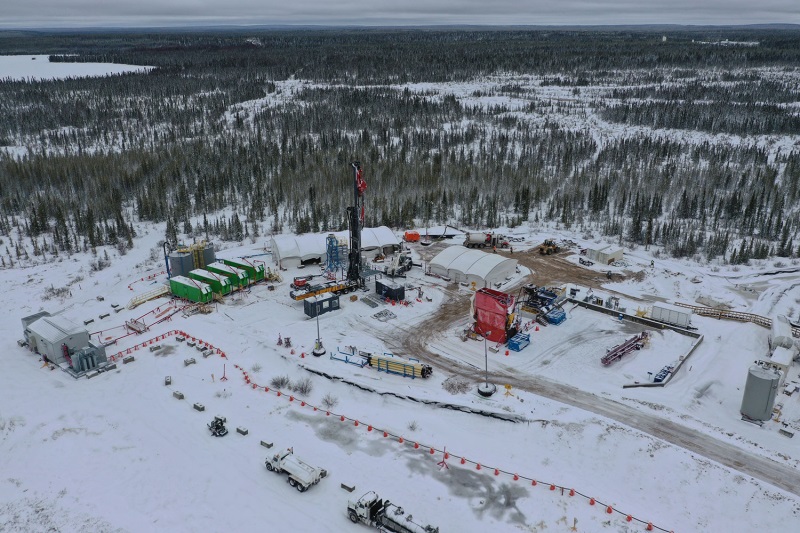
SABRE - a new mining method coming to life
Canada’s deposits are high-grade, but deep and not easily accessible.
Canada is number 3 country in the world when it comes to uranium resources and number 2 in uranium production, so it’s a priority country for Orano’s exploration efforts, especially the uranium-rich Athabasca basin in the northern reaches of the country. However, in all probability the majority of the larger, close-to-the-surface and easily accessible deposits have been already discovered, with most current exploration targets generally looking at depths as far down as 1,000 meters.
Although high- grade in nature (up to 15%), new Canadian deposits are often small in size and difficult to access due to their depth and the difficult geological or environmental settings.
The ground-breaking mining method developed by Orano’s engineers can make many of these deposits not economically viable today, accessible tomorrow.
What does make the SABRE different from conventional mining methods?
SABRE is based on hydraulic borehole mining. This non-entry vertically selective approach to mining involves drilling access holes from the surface and extracting the underlying ore by cutting the ore using a high-pressure
water jet and air-lifting the slurry to surface. It is a promising alternative to traditional open-pit or underground mining methods.
Perseverance and on-going innovation
Historically it has taken approximately 15 to 20 years between first finding a deposit and generating production.
“As we have seen with SABRE and other mining new mining methods before it, it also takes years of R&D work, testing and on-going improvement efforts to bring a new mining method to life. Such timelines require forward-looking vision to bring these innovative ideas to industrialisation”, explains Nicolas Maes, Orano Mining CEO
Orano Mining does think long-term, one of our commitments to our customers is to provide them with 20 years of visibility of supply. This means continuous investment in exploration and innovation.
The SABRE mining method has been in development for over a decade. It was first conceived in 2004 and, by 2007, Orano engineers proved the technical viability of borehole mining. Since then, we have made significant progress in developing SABRE equipment,
using test mining, design engineering and re-engineering. The SABRE mining method received a Canadian patent in February 2016 and a US patent in 2019

SABRE test at McClean Lake, 2021
Today SABRE work is carried out by the McClean Joint Venture (Operator Orano Canada, 77.5%, and its partner, @Denison Mines, 22.5%). The tooling (mining pipes and rig top drive) have been developed in cooperation with the JV’s contractor BAUER Resources.
Three main advantages of SABRE
Today, more than ever, it is necessary to look into the sustainability of mining and pay particular attention to all the potential impacts of the technology we use.
SABRE is a sustainable method as it offers economic, safety and environmental advantages
Economic advantages: Flexibility & Scalability
- It provides access to the resources not economically viable using traditional mining methods
- With a potentially short production ramp-up ( months instead of years), SABRE’s flexibility is suited to ever-changing uranium market conditions .
- The system is scalable, adaptable to market conditions and processing windows
Safety advantages: Health & Injury risks minimized
- As an non-entry mining method the operations are highly mechanized and utilize remote equipment from the surface. The method requires minimal manpower, minimizing the risk of potential human contact and injury.
- Ore is transported within piping that is designed to provide a barrier against gamma, radon and radioactive dust, resulting in reduced radiation exposure.
 SABRE operator
SABRE operator
Environmental advantages: Small surface footprint & Reduced water & power consumption
- Its small surface footprint eliminates the need for the excavation of large amounts of overburden or the storage of large amounts of waste rock. Decommissioning happens as production progresses as mined cavities are immediately backfilled upon completion.
- Reduced water usage and power consumption also contribute to potential reductions in greenhouse gas emissions and improved sustainability.

SABRE test at McClean Lake, 2021
SABRE is the way to go
The final stage of a five-year field test was completed from May to September 2021 with four mining cavities successfully excavated to produce approximately 1,500 tonnes of high-value ore ranging in grade from 4% U3O8 to 11% U3O8.
Orano and Denison Announce Successful 2021 Mining Test Showcasing SABRE Potential
Although there are still a number of steps remain before the decision is taken to start mining with this new tool, the McClean Lake and Midwest properties near the McClean Lake mill are already appearing as upcoming targets for being mined using the SABRE method. Orano team is confident that SABRE technology is the way to go for future mining in the Athabasca region, unlocking the potential resources not accessible today.